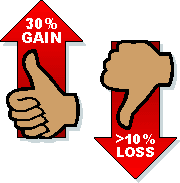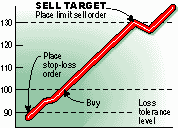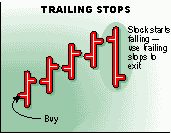
HOT TOPICS LIST
- Strategies
- Stocks
- Buy
- Investing
- Brokers
- Psychology
- Interviews
- Accumulate
- Sell
- Hold
- Spotlight
- Websites
- Candlestick Corner
- Gold & Metals
- Options Trading
LIST OF TOPICS
MONEY MANAGEMENT
Dodge Your Own Market Disaster
04/30/01 05:30:05 PM PSTby RM Sidewitz, Ph.D
There's no foolproof method of avoiding a market meltdown, but there are some steps you can take to dramatically reduce the possibility of getting caught in the conflagration.
| If you've been investing for a long time, you know that bear markets exist - even if the memory of them has been obscured by bullish euphoria in recent years - and you know that they are no fun. To avoid your own personal market crash, create a sensible strategy to get out of the market when the time comes. Whenever you buy a stock or mutual fund, you not only need to know at what price you will enter the market, but also at what price and under what conditions you will exit.
Think out your tolerance levels for Say you decide that you'll be happy with a 30% gain (wouldn't we all?) but are unwilling to take more than a 10% loss. If you bought shares at 100, your exit strategy would have you selling the stock when it reaches either 130 on the upside or 90 on the downside. These limits should be reflected as actual orders placed with your broker, so you don't have to watch the market on a day-to-day basis. THE EXIT A sound exit strategy should be carefully thought out. Research different approaches before you choose one (you'll find more articles about market timing at www.working-money.com), and use what you learn to create an exit strategy that works well for you. The following steps will get you started: 1. After buying a stock, place a limit sell order? at your target exit price. When the stock trades at or above your limit price, the order should be executed and the stock sold. Limit orders are executed at your limit price or better. There are occasions when you may sell your stock at a better price. That can happen this way: Suppose you entered a $130 limit sell order. When the markets opened, the price of the stock was $131.50 - higher than your limit order. The order should still be executed at the higher price because the price reached and exceeded the limit of your order. 2. To protect yourself against unusually high losses, use a stop-loss? order placed at your maximum tolerable loss. This can either be a percentage of your investment or a fixed-dollar amount. In this example, the stop-loss would be set at $90 because you are not willing to lose more than $10 on the position. 3. If your time window for the investment is less than two years, it might be to your advantage to use a trailing-stop? order. A trailing stop follows the stock on its way up, from one week or month to the next. As soon as the stock starts to fall, the stop order is triggered and the order executed. You can use different strategies to apply the trailing-stop order:
As the stock price approaches your target, reevaluate your goal. You might want to adjust the profit point. If you do, be sure to adjust your initial stop (the one you placed at the 10% loss point) as well. It would make sense to move it, at least to the point where you would break even (after costs) if the market were to turn against you. R.M. Sidewitz is chief executive officer and founder of Qi2 Technologies, LLC, an investment management company, and the managing member of Qi2 Partners LP, a domestic hedge fund. For additional information on long-term investing, go to www.longterminvestor.org.
Sidewitz, R.M. [2001]. "Is Buy-And-Hold The Strategy For You?" Working Money, Volume 2: April.
Copyright © 2001 Technical Analysis, Inc. All rights reserved.
|
Dr. Sidewitz is the President, Chief Executive Officer and founder of Qi2 Technologies, LLC, an investment management company and the Managing Member of Qi2 Partners LP, a domestic hedge fund. Dr. Sidewitz began his career on Wall Street in the mid-1960s with Moody's Investors Service. He then served as the Assistant Director of Research for a registered broker/dealer until 1971. In the ensuing years, he continued his pursuits as a private investor during which time he developed the proprietary methodology that is used by the Limited Partnership. Dr. Sidewitz is the author of two books, "How I Double My Money Annually in the Market" and "How to Stop Sabotaging Your Trading Success: Mastering the Inner Realm". He is a frequent contributor to numerous financial publications and continues to work closely with private clients.
| Title: | Managing Partner |
| Company: | Qi2 Technologies LLC |
| Address: | 4800 Baseline Road, Suites E104-370 |
| Boulder, CO 80303 | |
| Website: | www.cybrlink.com |
| E-mail address: | roy@cybrlink.com |
Traders' Resource Links | |
PRINT THIS ARTICLE

|

Request Information From Our Sponsors
- StockCharts.com, Inc.
- Candle Patterns
- Candlestick Charting Explained
- Intermarket Technical Analysis
- John Murphy on Chart Analysis
- John Murphy's Chart Pattern Recognition
- John Murphy's Market Message
- MurphyExplainsMarketAnalysis-Intermarket Analysis
- MurphyExplainsMarketAnalysis-Visual Analysis
- StockCharts.com
- Technical Analysis of the Financial Markets
- The Visual Investor
- VectorVest, Inc.
- Executive Premier Workshop
- One-Day Options Course
- OptionsPro
- Retirement Income Workshop
- Sure-Fire Trading Systems (VectorVest, Inc.)
- Trading as a Business Workshop
- VectorVest 7 EOD
- VectorVest 7 RealTime/IntraDay
- VectorVest AutoTester
- VectorVest Educational Services
- VectorVest OnLine
- VectorVest Options Analyzer
- VectorVest ProGraphics v6.0
- VectorVest ProTrader 7
- VectorVest RealTime Derby Tool
- VectorVest Simulator
- VectorVest Variator
- VectorVest Watchdog



